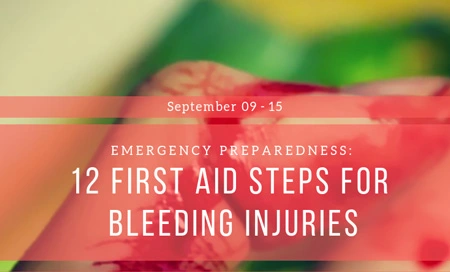
During an emergency, a few minutes can mean the difference between life and death, so you must act quickly. Prepare in advance by learning life-saving techniques so, in those crucial minutes, you know what to do. Today’s topic: bleeding injury first aid.
Bleeding should be stopped as soon as possible. Excessive blood loss can cause shock, fainting, or death, while an untreated wound can lead to infection. Follow these general bleeding injury first aid steps to stabilize a victim until medical help can arrive.
General Bleeding Injury First Aid
- Contact emergency medical services. Call 911 if the bleeding is severe, spurts, or doesn’t stop after 10 minutes or pressure. Also, call 911 if the injury is in the chest or abdomen or if you suspect internal bleeding.
- Get a first aid kit. A first aid kit should contain all the equipment you will need to treat the injury. If there is someone else with you, send them to get the kit while you stay with the victim.
- Put on gloves. If the victim is conscious, have them apply pressure to the wound with gauze or a clean rag as you put on gloves. If they are unconscious, put on the gloves then apply pressure to the wound with the gauze or rag. Gloves will protect both you and the victim from infection.
- Clear away obstructions. Cut away any clothing that prevents you from exposing and dressing the wound properly. Also, carefully wipe any foreign objects near the wound away with a clean material.
- Clean the wound. If you notice debris or contaminants in the wound, clean them away with water. Use soap and water to clean the area around the wound, but do not directly clean the wound. Do not pour alcohol or iodine into the wound.
- Apply pressure and elevate. With gauze or a clean rag, apply pressure to the wound to stop bleeding. If possible, wrap it with sterile gauze or other sterile material. The wound should be completely covered. Elevate the injury above the victim’s heart if possible.
- Do not remove the dressing. Do not remove any dressings to check the injury or if the blood has soaked through. If blood has soaked through, add additional layers of gauze and apply more pressure to the wound until the bleeding stops or medical help arrives.
- Keep the victim calm. A racing heart means the blood pumps faster, meaning more will bleed out. Calm the victim and be ready to treat for shock, if necessary.
What You Shouldn’t Do
While applying bleeding injury first aid, there are many things you should avoid. To avoid making the problem worse, make sure to follow these following tips.
- Don’t apply pressure to arterial bleeding. If the injury spurts, that means an artery is damaged and direct pressure won’t stop the bleeding. Apply pressure with fingers at the nearest pressure point between the wound and heart and contact medical assistance immediately.
- Don’t remove an impaling object. In extreme cases where the victim has been impaled, removing the object will make them bleed out faster. Leave the object in place until help arrives.
- Don’t apply non-medical materials to wound. Don’t use things like dirt, kerosene, lime, or coffee to stop the bleeding. They will make the injury worse or cause infection.
- Don’t apply tourniquets. Do not use rope, wire, etc. to stop the bleeding. Only use a tourniquet for extreme cases such as partial or complete amputation or as a last resort.
For more information on first aid procedures, Safety Provisions and Hard Hat Training offers the First Aid and CPR training. Additionally, our new Emergency Response Training is available. For other HR or heavy equipment trainings, visit us at www.hardhattraining.com.
Good luck and stay safe.
